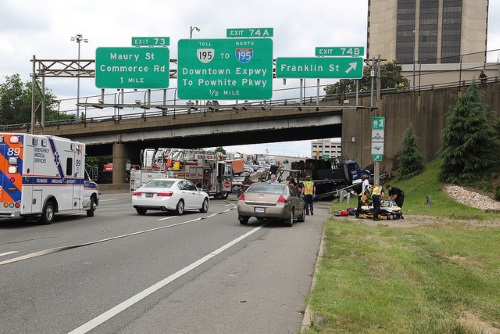According to the 2019 traffic fatality data report released by the National Highway Traffic Safety Administration on December 18, traffic deaths decreased by 2 percent in 2019 compared to 2018, even though vehicle miles traveled or VMT increased by 0.8 percent.
[Above photo by the Virginia DOT]
As a result, the fatality rate for 2019 dipped down to 1.10 fatalities per 100 million VMT – the lowest rate since 2014 – from 1.14 fatalities per 100 million VMT in 2018.

“We are encouraged by the 2019 FARS [Fatality Analysis Reporting System] data, which shows that fewer lives were lost on our nation’s roads than the year before, a trend for three years now even while economic growth was increasing,” noted James Owens, NHTSA’s deputy administrator, in a statement.
“We saw notable reductions in pedestrian and cyclist fatalities, as well as fewer lives lost in alcohol-impaired driving crashes,” he added. “If we’re to keep building on these numbers, everyone needs to do their part by driving sober, wearing their seat belts, avoiding speeding and distractions, and sharing the road with pedestrians and cyclists.”
According to NHTSA’s data, there were 36,096 fatalities in motor vehicle traffic crashes in 2019 – a decrease of 739 or 2 percent from 36,835 fatalities in 2018,
The agency added that fatalities also decreased in most major traffic safety categories in 2019 compared to 2018, including:
- Passenger vehicle occupant fatalities: 630 fewer fatalities, a 2.8 percent decrease.
- Pedestrian fatalities: 169 fewer fatalities, a 2.7 percent decrease.
- Pedalcyclist fatalities: 25 fewer fatalities, a 2.9 percent decrease.
- Alcohol-impaired driving fatalities: 568 fewer fatalities, a 5.3 percent decrease.
However, NHTSA noted in a special supplementary report on traffic fatality rates that while overall traffic fatalities from April to June 2020 are projected to decrease, there is an increase in the proportion of fatalities occurring in rural areas; among people aged 16 to 24; with risky drivers, in rollovers and ejections, and among occupants of older vehicles.
The agency added that higher fatality rates on rural local/collector, arterial, and interstate roadways during the first half of 2020 are driving those rising category numbers for 2020.
 Top Stories
Top Stories
USDOT Makes $1.5B Worth of BUILD Grants Available
December 19, 2025 Top Stories
Top Stories

